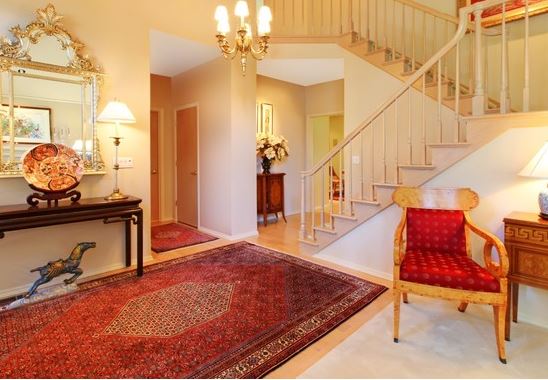Persian Bijar Rug ( Bidjar Rug)
Bijar rugs (Bidjar rugs) are counted among the best oriental rugs. Bijar rugs (Bidjar rugs) have a very dense hard pile. Antique Bijar rugs (Bidjar rugs) are very different from newer Bijar rugs (Bidjar rugs).
Bijar rugs (Bidjar rugs) are counted among the best oriental rugs for everyday use because they are extremely tough and rigid. The most common pattern is the Herati (also called fish pattern), but also medallions and floral motifs occur. are manufactured in most sizes, from zaronim (150×100 cm) and larger sizes. They have a sober elegance and fit in most environments. Their durability makes the carpets very suitable for public environments. The region’s weavers have transformed many classic antique Bijar rugs (Bidjar rugs) designs with their own interpretations. “Mina khani” and “Herati” Persian rug designs (both highly detailed, overall repeats) and a diamond-shaped medallion were frequently used. An anchor-like design is found in many antique Bijar rugs (Bidjar rugs) at the vertical ends of the medallion or as the pendant motif.
Ground colors are harmonious, a product of the blending of subtly shaded patterns. Dark blue and a strong red predominate. Brown and yellow are also used, but green is rare. Some old Bijar rugs (Bidjar rugs) are woven with combinations of light and dark blue. Superbly crafted Bijar rugs (Bidjar rugs) were produced in the small workshops of Bijar itself, the finest of the area size Bijar rugs (Bidjar rugs) being called “Halvai.” Many of the best antique Bijar rugs (Bidjar rugs), especially the largest antique Bijar rugs (Bidjar rugs), have been commissioned by Westerners and the Persian nobility for the last several hundred years. Spontaneous, asymmetric antique tribal Bijar rugs (Bidjar rugs) were woven at the family level throughout the surrounding countryside. Bijar rugs (Bidjar rugs) have a very dense hard pile, cut medium to high, though old and antique finely woven pieces tend to be clipped lower.
Stylized allover flower and vinery motifs are also found in the small Bijar village pieces and larger city rug alike. Two particularly rare and prized Bijar rugs (Bidjar rugs) designs are “Garrus” and “Guli Farang.” The Garrus design usually employs a cobalt to midnight indigo blue field and a distinctive large scale all-over pattern of split-arabesques and blossoming vinery in the field, along with a ribbon-like, serpentine and cloudband repeat in the main border. The finest antique Bijar rugs (Bidjar rugs) have woven 1900 or before are grand works of refined art, yet they possess tribal elements in their design and coloration which are not found in any other city rugs.
Herti and Mina Khani designs are very common in Bijar rugs (Bidjar rugs). You can also find medallion and all-over patterns with multiple borders. Bijar rugs (Bidjar rugs) are world renowned for their superb artistry, craftsmanship, and excellent material, and can be distinguished by their heavy wool foundation (cotton in twentieth-century rugs). As the weaver tied each row of knots, she added an extra weft and literally pounded down the knots. The stiff, heavy foundation that is thus created allows antique Bijar rugs (Bidjar rugs), known as “the iron rugs of Persia,” to withstand up to 200 years of heavy use. Bijar rugs (Bidjar rugs) come in different sizes, especially from about 1 x 1.50m (3′ 3″ x 4’x 11″) upwards. Large pieces of over 12 square meters (51 square feet) are common. The examples woven by Kurdish women in the small surrounding villages display an exceptional level of spontaneity. Known as “Kurdish Bijar” to differentiate them from the more finely woven and formal “Bijar” style, the best examples use strong abrash, or tonal changes within one hue, and sometimes radical changes in design. They have the same superb wool and color range as the more finely woven city Bijars.
Not all Bijar rugs (Bidjar rugs) are the same. Antique Bijar rugs (Bidjar rugs) are very different from newer Bijar rugs (Bidjar rugs). Antique Bijar rugs (Bidjar rugs) tend to be substantially coarser than the new. The warp and weft which is the frame upon which the knots are tied are far more substantial. The heavy weft which gives the Bijar rugs (Bidjar rugs) it’s characteristic construction is thick and straight. The older the rug the more likely the warp and wefts are to be wool but we see cotton in antique Bijar rugs (Bidjar rugs) as well. Warp of Bijar rugs (Bidjar rugs) is of cotton or, less frequently, goat’s wool. Weft of Bijar rugs (Bidjar rugs) is cotton and both warp and weft yarn is tightly spun. In old and antique Bijar rugs (Bidjar rugs) pieces, warp and weft are of wool. Most Bijar rugs (Bidjar rugs) are woven by Kurd and Afshar weavers of the Gerus region around the town of BIJAR in western IRAN. Bijar rugs (Bidjar rugs) are divided into the following formats:
Traditional Bijars (Bijars with rose motifs)
Halvai and Tahjavi-Bijars
Afshar Bijars BIJAR rug designs are difficult to define.
The majority of Bijar rugs (Bidjar rugs) have Turkish knots. However, Persian knotted pieces are also found. The Guli Farang, translated as “Foreign Flower” antique Bijar rugs (Bidjar rugs) pattern is also an all-over repeat, that many believe to be a stylized depiction of cabbage blossoms or a English formal garden. In pieces woven before 1900, this motif usually is performed against a dark blue or ivory ground.
The antique Bijar rugs (Bidjar rugs) color palette, from soft to emerald greens, a full range of blues and yellows to fiery rich red, tomato or deep terra cotta, demonstrates the great skill of its dyers. BIJAR is one of the fertile areas of Kurdestan. Its climate is cold and dry in winter and moderate in summer. In the Kurdish language, the willow tree is called ‘Bi’ and an area of such trees is called a ‘Bijar’– the region of willows-so named because of the abundance of willow trees. Although the small Kurdish town of BIJAR in the province of Kermanshah has hardly ten thousand inhabitants, the high quality of its rugs has gained it an international reputation. Concern for this reputation for high quality led to a clear distinction being made between the products of the BIJAR town workshops and the Tekab-BIJAR, which are woven by an Afshari tribe that settled in the area.
Bijar is a market center in Northwestern Iran, about 150 miles south of Tabriz. The flat, dusty town of Bijar and the surrounding countryside are populated mainly by Kurds, whose artistic sense and culture is clearly seen in the region’s grand antique Bijar rugs (Bidjar rugs). A small city of 20,000 at the turn of the century, Bijar was the center of a major weaving area. BIJAR rugs have a very unique weave that uses the symmetrical Turkish knot and double weft compacted very tightly, thus making them heavy and durable rugs. The characteristic weft technique used in the Kurdish BIJAR area gave rise to the term BIJAR structure. The strong tension of the weft pulls the warp into two layers, giving the carpet a certain rigidity. Though strong, if handled carelessly or folded, it will crack and tear.
Source:
http://www.oldcarpet.com
http://www.carpetencyclopedia.com
http://www.persiancarpetguide.com
http://www.houzz.com






